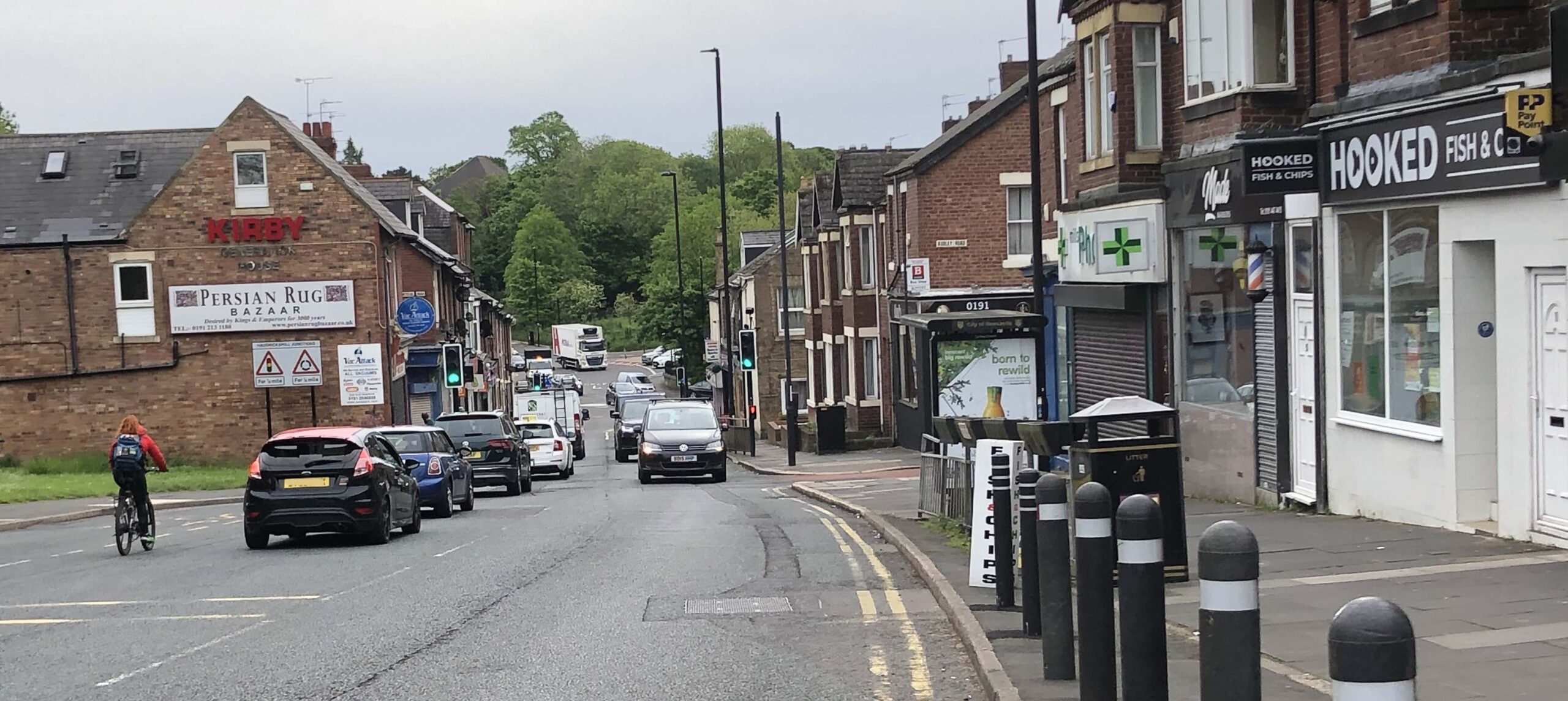
Station Road – May 2022
Residents have reported high volumes of motor traffic and delays on Station Road, with this often being attributed to the effect of closing a number of minor roads to through traffic in 2020. In this blog we take another look at local traffic count data to see what is going on.
Closing local bridges – Recap
In May 2022, we looked at traffic levels on Station Road after local bridges were closed to through traffic. We found that traffic levels on Station Road did not increase after local bridges were closed to traffic, and in fact stayed at a similar level to 2018, as shown in the graph below.
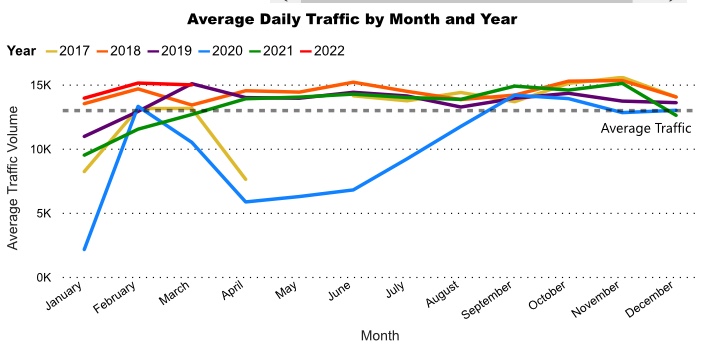
Traffic Volumes on Station Road, measured 30m west of Bowsden Terrace – Data Extract May 2022
Traffic levels remained similar right up to March 2022, the latest month we had data for at the time, 19 months from when the bridges were closed in August 2020 and 12 months from when schools reopened (and traffic fully returned to normal) following Covid lockdowns in March 2021.
What happened then?
Now we have another year of data and we can see traffic levels on Station Road did increase after April 2022, by up to 10% in some months. This is shown on the red line (2022) and higher blue line (2023) in the graph below.
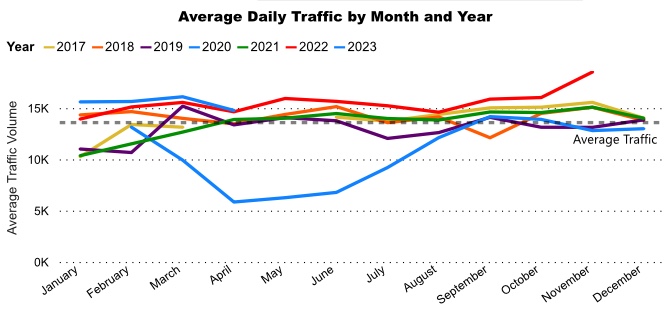
Traffic Volumes on Station Road, measured 30m west of Bowsden Terrace – Data Extract May 2023
In November 2022, traffic levels on Station Road were extremely high, averaging 18,525 vehicles per day over the month.
Why did traffic increase?
If the bridges were to have an effect it would most likely have been immediately after they were closed to traffic i.e. August/September 2020, and not at some random time over two years later, and they wouldn’t explain the unusually high traffic levels in November 2022.
One explanation could be overall growth in traffic, and consequently growth in traffic jams, aided by the Government’s fuel duty freeze. Since the start of the freeze in 2010 up to 2019, miles driven in Newcastle increased by nearly 7%, but again this would not explain the unusually high traffic levels in November 2022.
There was a local traffic ‘event’ in the autumn of 2022 – emergency roadworks for gas repairs on Jesmond Dene Road. These works lasted from May to December 2022, with the main works (and greatest disruption) between 24 October and 2 December.
A189 Jesmond Dene Road, reports of failed temp traffic signals at the junction of Moorfield for the works being carried out by @NGNgas #Newcastle pic.twitter.com/9roIBPVP0k
— North East Live Traffic (@NELiveTraffic) November 29, 2022
Between 4 – 14 November Jesmond Dene Road was closed to all traffic at the junction with Moorfield.
https://twitter.com/NewcastleCC/status/1588573686000394240
We reported at the time that Google Live Traffic was showing heavy traffic on The Grove and, to a lesser extent, Ilford Road. The maps in the tweets below also show slow moving traffic on Station Road.
Google Live Traffic shows lots of driving on residential streets. We need low traffic neighbourhoods so that main road traffic stays on the main road network. pic.twitter.com/rWFzwKLdS8
— space for gosforth (@space4gosforth) November 7, 2022
Residents of The Grove also reported traffic was very busy, as well as higher noise levels and a collision as a result of the additional traffic.
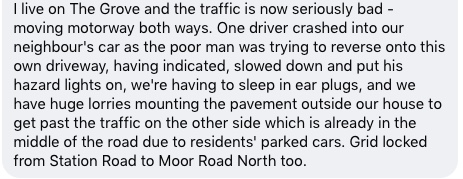
Comment on Gosforth Traffic Facebook 11 November 2022
Traffic using The Grove as an alternative route would have been picked up by the Station Road traffic counter, explaining the increase in traffic levels between May and December. We can see from weekly traffic counts that the most traffic on Station Road was the week where Jesmond Dene Road was closed completely (7 November).
| Date 2022 | Station Road Traffic Count |
| 24 October | 16,466 |
| 31 October | 19,042 |
| 7 November | 21,337 |
| 14 November | 16,934 |
Displaced traffic
We also have traffic volumes for Haddricks Mill Road for the same period. The graph below shows that, from the start of roadworks in May 2022, there is a corresponding reduction in traffic levels on Haddricks Mill Road.
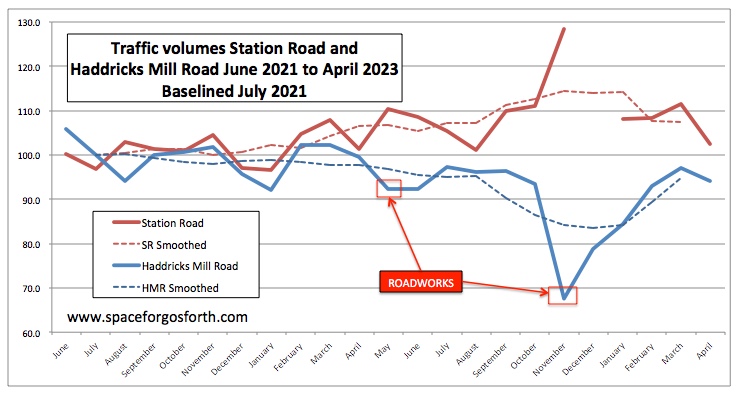
This may come as a surprise to residents of Haddricks Mill Road, for whom this whole period (apart from when the road was fully closed) was marked by continual traffic jams due to the road works.
This is to be expected though, as a temporary reduction in road capacity caused by temporary traffic lights will cause both traffic jams and a reduction in traffic volumes on the affected roads as some people take alternative routes.
Total gridlock (and CO2 galore) outside our homes EVERY morning in #SouthGosforth. I guess it makes a change from the dangerous speeding… @NewcastleCC any plans to address?? This isn’t sustainable. pic.twitter.com/iwiPrByUf6
— Ciara Small (@SmallWorldNE) May 24, 2022
This contrasts with permanent or longer-term road capacity reductions where it has been found that “significant reductions in overall traffic levels can occur, with people making a far wider range of behavioural responses than has traditionally been assumed“. This is why traffic changes are often trialled over a 6-18 month period, and why other long-term local road closures have shown no increase in traffic volumes on parallel roads.
Following completion of the road works, traffic counts also show that Haddricks Mill Road traffic levels didn’t immediately return to where they were, taking until March 2022 to return to previous levels.
Conclusion
- Traffic levels did increase on Station Road in 2022, up to about 10%, with a corresponding decrease on Haddricks Mill Road. The most likely reason for this was the road works on Jesmond Dene Road.
- Some of the traffic that would have used Haddricks Mill Road rerouted to use Station Road via The Grove. Roads east of Stoneyhurst Bridge remained largely traffic-free.
- This contrasts starkly with previous local road closures. No additional traffic was recorded on parallel routes following Stoneyhurst Road, Castle Farm Road or Killingworth Road closures. This may be because the roadworks on Jesmond Dene Road were announced with very short notice, and were only for a short period, so people weren’t able to or didn’t feel the need to adjust.
- Traffic using The Grove instead of Jesmond Dene Road will have created additional delay for people travelling by car/bus from Gosforth High Street to Haddricks Mill.
- Where there is short-term disruption, traffic will divert via whatever routes are available. While these routes are open to through-traffic, neither residents nor people wishing to walk or cycle away from heavy traffic can rely on them remaining low-traffic routes.
- Traffic levels on Station Road and Haddricks Mill Road appear to be returning to closer to historical (still very busy) levels since March 2023, however while motoring is relatively cheap compared to public transport and there is a lack of safe cycling routes, traffic levels are likely to continue to rise. Higher levels of traffic contribute to increased pollution, carbon emissions and danger for other road users, much more than localised congestion.
Reference – Other Traffic Reports
- Temporary traffic lights due to gas main work and roadworks on A189 Jesmond Dene Road at Moorfield – May 2022.
- Temporary traffic lights due to gas main work on A189 Matthew Bank at Jesmond Dene Road – September 2022
- Temporary traffic lights due to gas main work on A189 Jesmond Dene Road at Moorfield – December 2022
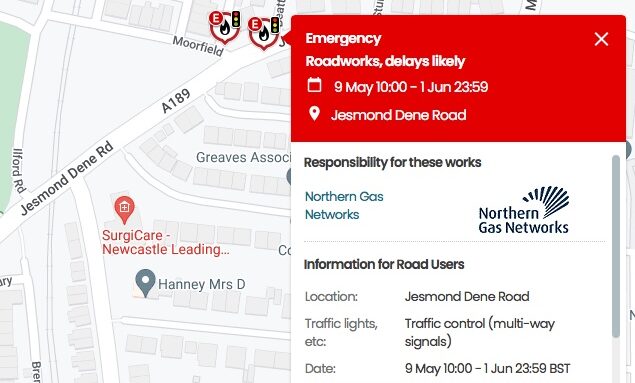

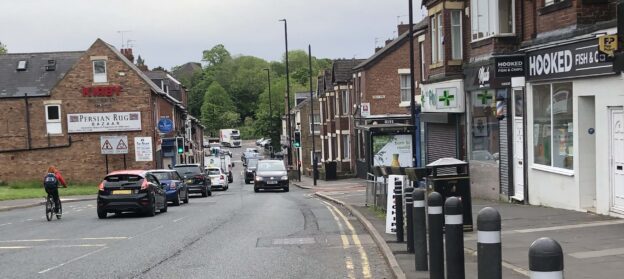
You’ve only got to look round and see the many new housing estates popping up north east and east of this area, with more housing and no infrastructure changes traffic levels will increase. The ethos of so many that the car is the only choice for all journeys needs to change. The increased theft risk of bicycles (and motorcycles) needs to be addressed giving motorists more confidence to try alternative forms of transport.